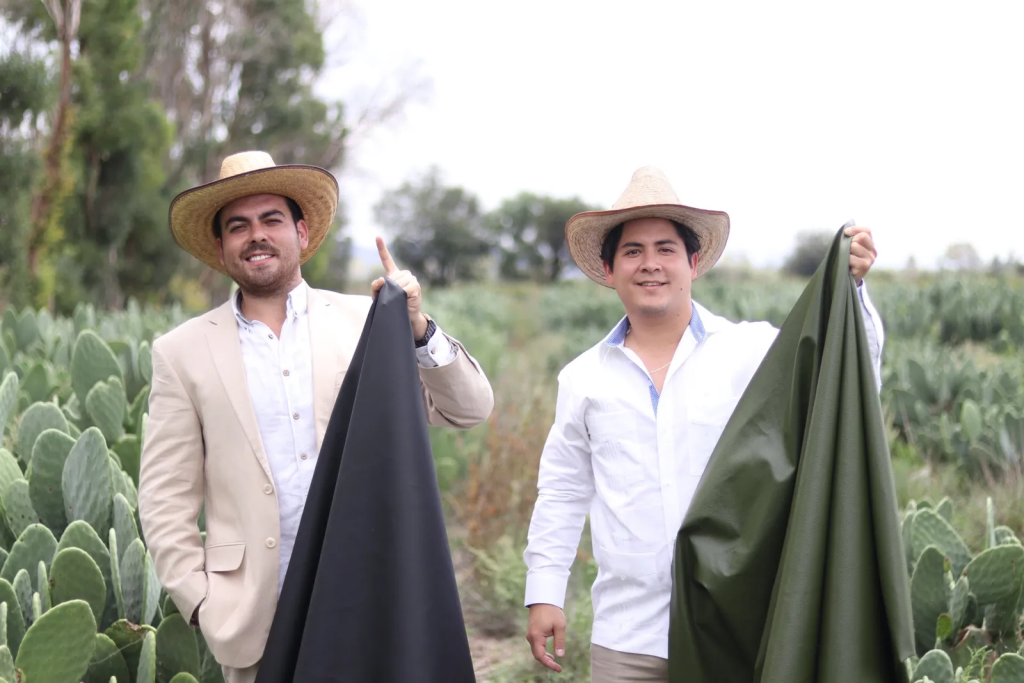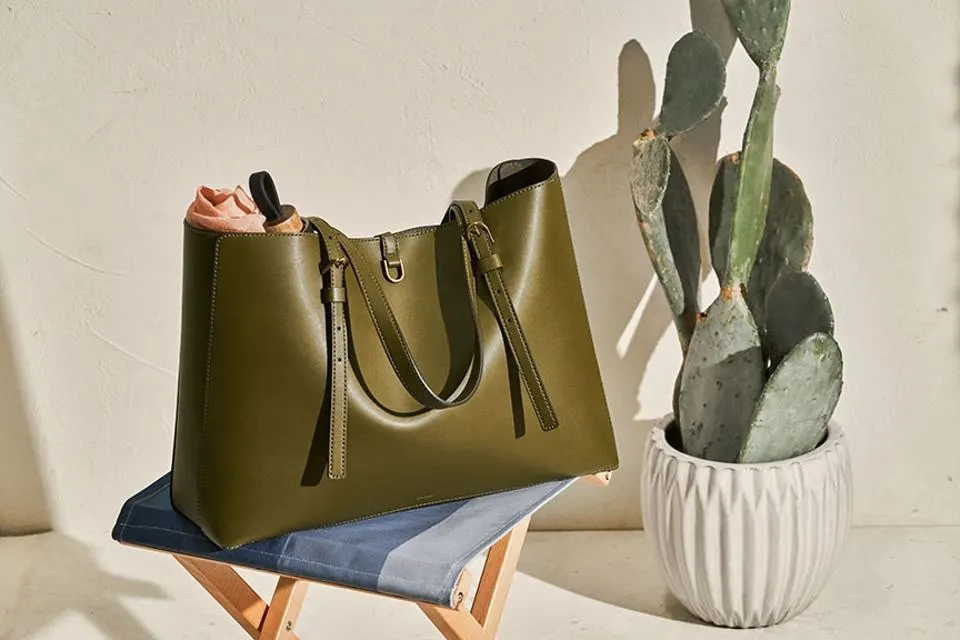In recent years, sustainability has become a critical concern in the fashion industry. The environmental impact of traditional leather production, including high water consumption, deforestation, and chemical pollution, has spurred the search for eco-friendly alternatives. Among these innovative materials, cactus leather has emerged as a promising solution.
Origins and Development of Cactus Leather
Cactus leather, also known as “desserto,” was developed by two Mexican entrepreneurs, Adrián López Velarde and Marte Cázarez, who sought to create a sustainable and cruelty-free alternative to animal leather. Their journey began in 2019 when they launched Desserto, a brand specializing in cactus-based leather. The duo’s vision was to address the environmental and ethical concerns associated with traditional leather while leveraging Mexico’s abundant cactus resources. The nopal cactus, commonly known as prickly pear, was chosen as the primary material due to its resilience, low water requirements, and widespread availability in Mexico. This species of cactus can thrive in arid environments with minimal water, making it an ideal candidate for sustainable leather production.

Production Process of Cactus Leather
The production of cactus leather begins with the cultivation of nopal cacti. These cacti are grown organically without the use of pesticides or herbicides, ensuring minimal environmental impact. The mature leaves are harvested every 6-8 months, leaving the cactus intact to regenerate and continue growing. This process allows for a continuous and renewable supply of raw materials.

Once harvested, the cactus leaves are cleaned and processed to extract the fibres. The fibres are then dried under the sun, reducing the need for energy-intensive drying methods. After drying, the fibres are ground into a fine powder, which is mixed with non-toxic, eco-friendly binders to create a malleable material. This mixture is then shaped into sheets and subjected to a curing process that enhances its durability and flexibility. The result is a leather-like material that closely mimics the texture and appearance of traditional leather.
Benefits of Cactus Leather
Environmental Sustainability: Cactus leather significantly reduces the environmental footprint compared to animal leather. Nopal cacti require minimal water, making them an ideal crop for arid regions where water scarcity is a concern. Additionally, the organic cultivation and low-energy production process minimise the use of harmful chemicals and reduce greenhouse gas emissions.
Animal Welfare: One of the most significant advantages of cactus leather is its cruelty-free nature. Traditional leather production involves the slaughter of animals, raising ethical concerns among consumers. Cactus leather provides a viable alternative that does not harm animals, appealing to the growing market of ethically conscious consumers.
Biodegradability: Unlike synthetic leather, which is often made from petroleum-based materials and can take centuries to decompose, cactus leather is biodegradable. This characteristic ensures that products made from cactus leather will have a reduced impact on landfills and contribute to a more circular economy.
Durability and Versatility: Cactus leather is not only sustainable but also durable and versatile. It can withstand wear and tear, making it suitable for a wide range of applications, from fashion accessories like bags and shoes to furniture and automotive upholstery. Its flexibility and ease of customisation further enhance its appeal to designers and manufacturers.
Challenges and Limitations
Despite its numerous benefits, cactus leather faces certain challenges and limitations that need to be addressed for its widespread adoption.
Scalability: The production of cactus leather is still in its early stages, and scaling up to meet global demand presents logistical and economic challenges. Establishing large-scale cultivation and processing facilities requires significant investment and infrastructure development.
Cost: Currently, cactus leather is more expensive to produce than traditional leather, primarily due to the limited supply chain and production scale. However, as demand increases and production processes become more efficient, the cost is expected to decrease, making it more accessible to a broader market.
Consumer Awareness: While there is growing interest in sustainable materials, consumer awareness of cactus leather is still relatively low. Educating consumers about the benefits and availability of cactus leather products is crucial for driving demand and encouraging adoption.
The Future of Cactus Leather in Fashion
The future of cactus leather in the fashion industry looks promising, with several factors contributing to its potential success.
Industry Adoption: Leading fashion brands are increasingly recognising the importance of sustainability and are actively seeking alternatives to traditional leather. Collaborations between cactus leather producers and major fashion houses can drive innovation and increase the material’s visibility in the market. Brands like H&M and Karl Lagerfeld have already shown interest in incorporating cactus leather into their collections, setting a precedent for others to follow.

Technological Advancements: Continued research and development in the field of bio-based materials will likely lead to improvements in the quality, cost-efficiency, and scalability of cactus leather production. Innovations in processing techniques and material formulations can enhance the material’s properties and broaden its range of applications.
Regulatory Support: Governments and regulatory bodies are increasingly implementing policies and incentives to promote sustainable practices in various industries, including fashion. Supportive regulations and subsidies for sustainable materials can accelerate the adoption of cactus leather and other eco-friendly alternatives.
Consumer Demand: As awareness of environmental issues continues to grow, consumers are becoming more conscious of their purchasing decisions. The demand for sustainable and ethically produced products is expected to rise, creating a favourable market environment for cactus leather. By highlighting its eco-friendly and cruelty-free attributes, brands can attract environmentally conscious consumers and build brand loyalty.

Cactus leather production in India
Cactus leather production in India is gaining momentum as an eco-friendly and sustainable alternative to traditional leather. Key players in this industry include:
Winner Nippon Leatherette Pvt. Ltd. – This company is a pioneer in cactus leather manufacturing in India, producing high-quality, sustainable leather alternatives. Their efforts are positioning Indian manufacturers as leaders in the global sustainable fashion market.

Arture – Based in Chennai, this vegan leather brand has expanded its product range to include cactus leather. This move enhances their commitment to sustainability and innovation in the fashion industry.
Conclusion
Cactus leather represents a groundbreaking innovation in the quest for sustainable and ethical materials in the fashion industry. Its environmental benefits, cruelty-free nature, and versatility make it a compelling alternative to traditional leather. While challenges such as scalability and cost remain, the future of cactus leather looks promising, driven by industry adoption, technological advancements, regulatory support, and growing consumer demand. As the fashion industry continues to prioritise sustainability, cactus leather has the potential to revolutionise the way we produce and consume fashion, paving the way for a more sustainable and ethical future.
Feature Image Courtesy: gunasthebrand





